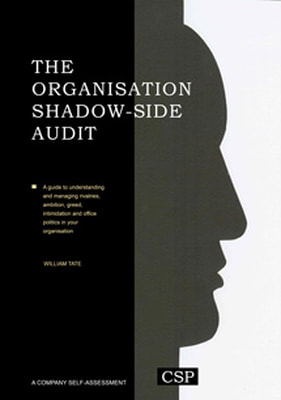|
Imprint: Cambridge Strategy Publications
Paperback List Price: £55.00 Format: Paperback Extent: 110pp. Size: A4 ISBN: 978-1-902433-97-4 Tags: Systems Thinking, Management, Leadership, Organisational Leadership, Shadow-Side The Organisation Shadow-Side Audit William Tate Buy the auditPaperback: Cost: £55.00
Buy the pdf (£20)Click the 'Buy' button below. At checkout, click No postage on ebooks from the dropdown.
After paying, we will send an immediate confirmation and email your ebook file within 24 hours. version: bookmarked pdf
(pdf text cannot be edited, printed or copied - email us if you need this capability.) |
The Organisation Shadow-Side AuditOrganisations are not rational. At best, they are peppered with petty office politics. At worst, they are crazy places, where the fog of irrationality is difficult to penetrate. In these organisations, rules and logic take second place to personal prejudices, rivalries and playing 'games'.
Yet what do most managers do when they need to improve the way their organisations are managed? They talk about rational things like injecting more resources and installing computers. They discuss organisation charts, mission statements, list of competencies and tasks. They set up committees and announce new reporting channels. They devise new rules and policies. They publish instructions and procedures. In fact, most organisational problems almost certainly have more to do with departmental rivalries, personal jealousies, ambition, greed, power struggles, self-interest groups, people not on speaking terms, politics, intimidation and fear. Even sexual attractions, liaisons and favours account for much of what does and doesn't get done 'according to plan'. Unfortunately, few managers are good at seeing and understanding, let alone managing, this real-life side to work. It is usually beyond the bounds of training, often out of bounds completely. Yet it is the real backcloth for much of what goes on inside organisations. Learn to understand and manage the shadow-side Use this audit to learn how to 'read', understand and manage the shadow-side to benefit the organisation as a whole:
For each of the 9 themes listed below, the audit includes a detailed introduction, a questionnaire (with 20-30 questions) and space to record your thoughts, ideas, conclusions and suggestions. The process of completing the audit is designed to help your organisation think, compare, illuminate, learn, plan and improve. Finally, there is an extensive guide and questionnaire to help you plan improvement actions. The audit's themes
ReadershipA practical toolkit for HR and other senior executives who want to understand and manage the shadow-side.
|

